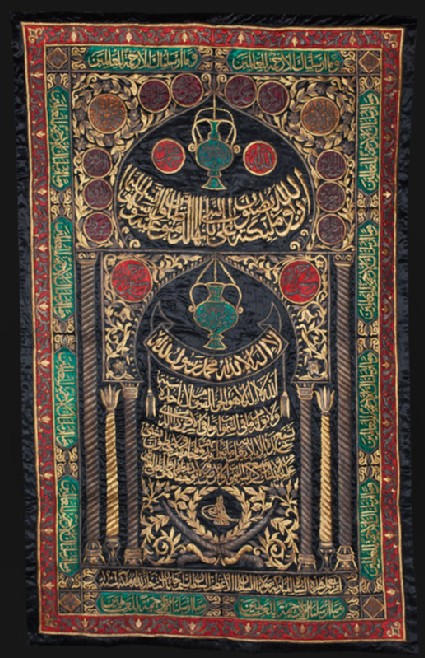Browse: 19 objects
- Reference URL
Actions
Sitarah made for the Mosque of the Prophet in Medina
-
Description
Embroidered textiles were amongst the most impressive gifts presented during the processions associated with the annual Islamic pilgrimage (hajj) to Mecca. Traditionally produced every year by the Muslim rulers who controlled the holy sites of Mecca and Medina, these costly objects were at once expressions of wealth and piety.
This curtain or sitarah was made for the mosque of the Prophet Muhammad (died AD 632) in Medina and was probably meant to be displayed near his tomb or by the mosque’s mihrab, the niche indicating the direction of prayer. The main design is also based on a prayer niche, which is adorned with a mosque lamp inscribed with the Qur’anic verse ‘God is the light of the Heavens and Earth’ (surat al-Nur, 29:35). Beneath it lines of bold inscriptions feature the shahada (Muslim profession of faith) and the ayat al-kursi (‘throne verse,’ surat al-Baqara, 2:255). An arch with mosque lamp and a further Qur’anic quotation (surat al-Ahzab, 23:56) are also found in the upper tier of the textile, surrounded by medallions that contain the names of Allah, Muhammad, and the four orthodox caliphs among others.
The curtain was commissioned by the Ottoman sultan Selim III (ruled 1789-1807), whose imperial monogram (tughra) lies at the centre of the wreath located between two crossed swords at the base of the arch. An inscription underneath it further confirms the attribution and also records the date of production, AH 1206 (AD 1791-1792).
-
Details
- Associated place
-
Asia › Saudi Arabia › Medina › Mosque of the Prophet (probable original location)
- Date
-
1791 - 1792 (AH 1206)
Ottoman Period (1281 - 1924)
- Associated people
-
Sultan Selim III (ruled 1789 - 1807) (commissioner)Abu Bakr (ruled AD 632 - 634) (named on object)'Ali ibn Abi Talib (ruled AD 656 - 661) (named on object)Prophet Muhammad (c. AD 570 - 632) (named on object)Husain ibn 'Ali ibn Abi Talib (AD 626 - 680) (named on object)Hasan ibn 'Ali ibn Abi Talib (AD c. 625 - 669) (named on object)Sultan Selim III (ruled 1789 - 1807) (named on object)‘Umar (ruled AD 634 - 644) (named on object)‘Uthmān (ruled AD 644 - 656) (named on object)
- Material and technique
- silk, dyed black, with coloured silk appliqué, partly padded with stitching in cotton, and embroidered with looped silver and silver-gilt wire secured with waxed cotton thread; cotton lining, dyed black
- Dimensions
- 268 x 164 cm (height x width)
- Material index
-
organic › animal › animal product › silk,
- Technique index
-
dyed,covered › metallized › gilded,
- Object type index
- No. of items
- 1
- Credit line
- Presented by Nasser D. Khalili and Family, 2012.
- Accession no.
- EA2012.3
-
Further reading
Christopher Brown, ‘The Burlington Magazine, Acquisitions (1998-2014) at the Ashmolean Museum, Oxford’, 1139, (2014)
Location
-
- currently in research collection
Objects are sometimes moved to a different location. Our object location data is usually updated on a monthly basis. Contact the Jameel Study Centre if you are planning to visit the museum to see a particular object on display, or would like to arrange an appointment to see an object in our reserve collections.
Collection trails
Galleries
© 2013 University of Oxford - Ashmolean Museum










